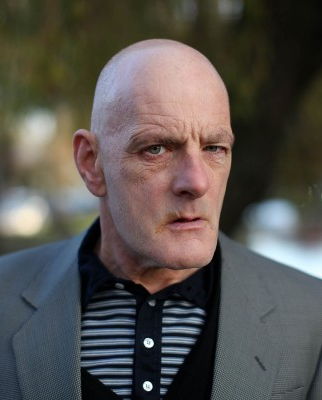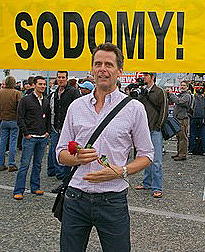|
presents THIS DAY IN GAY HISTORY based on: The White Crane Institute's 'Gay Wisdom', Gay Birthdays, Gay For Today, Famous GLBT, glbt-Gay Encylopedia, Today in Gay History, Wikipedia, and more …
Collected by Ted December 10 [{(o)}]|[{(o)}]|[{(o)}]|[{(o)}]| [{(o)}]|[{(o)}] 1725 – In England, Margaret Clap was indicted for keeping a disorderly house – a molly House – in which she procured and encouraged persons to commit sodomy. Her house in the City of London had long been under surveillance. Her house was one of the most popular molly houses in London, and was probably a private residence rather than a public inn or tavern. Margaret Clap was found guilty and sentenced to stand in the pillory in Smithfield market. She also had to pay a fine of 20 marks and to two years’ imprisonment. During her punishment, she fell off the pillory once and fainted several times. It is not known what became of her if, indeed, she survived prison.
1792 – Virginia eliminates its reliance on the English buggery statute by passing its own statute that retains the death penalty.
1828 – New York lowers the penalty for sodomy from life imprisonment to a maximum of ten years.
1830 – On this date the American poet Emily Dickinson was born in Amherst, Massachusetts (d.1886). In her twenties, Emily led a busy social life, but she became more reclusive with each passing year. By her thirties, she stayed to her home and withdrew when visitors arrived. She developed a reputation as a myth, because almost never seen and, when people did catch sight of her, she was always wearing white. But while she withdrew from physical contact with people, she did not withdraw from them mentally. Emily was an avid letter-writer who corresponded with a great number of friends and relatives. A thousand of these letters (a portion of what she wrote) survived her death, and they show her letter writing to be very similar to her poetic style--enigmatic and abstract, sometimes fragmented, and often forcefully sudden in emotion. Emily often included poetry with her letters to friends. Her friends encouraged her to publish, but after an attempt to do so in 1860 (when the publisher suggested she hold off) Emily did not appear to try again. The eight poems that were published in her lifetime were primarily poems submitted by her friends without her permission. Her death revealed 1768 more poems. The idea of finding out who inspired Emily to write so prolifically has intrigued literary researchers for decades. For a while, the popular assumption was that she had a male mentor encouraging her, and that this is perhaps the person she addressed in three letters written to "Master." Some have speculated she was in love with Samuel Bowles (editor of a prominent local newspaper) for a time, and others speculate that she had a relationship with Judge Otis Lorde, and either of these men could have been the mysterious "Master." She may have been in love with both or either of these men; it's hard to confirm or deny the nature of her involvements with them. But the evidence that is available seems to show that the person who most affected her life and her work was Susan Gilbert- friend, eventual sister-in-law, and Emily's passionate love. This is the woman about whom Emily wrote hundreds of poems, and the person who received three times more poems of any of Emily's other friends. Susan and Emily probably met at Amherst. They were close friends from the beginning, sharing similar interests and desires. Emily trusted Susan completely, and was very affectionate toward Susan in all their correspondence. While Susan seems to have responded initially, Emily's attention turned cloying when Susan became engaged to Austin Dickinson, Emily's brother. For two years, their correspondence stopped completely. When Susan and Austin moved next door, their correspondence resumed again, and Emily continued her expressions of worshipful love. Feminist scholars who have examined Emily's letters from a Lesbian viewpoint note that her letters move beyond romantic friendship to the blatantly passionate. It isn't possible to know how Susan responded to Emily's proclamations of love, her desires to hold and kiss Susan, or her sorrow at being without Susan. When Emily died, all of Susan's letters were destroyed. Dickinson was buried, laid in a white coffin with vanilla-scented heliotrope, a Lady's Slipper orchid and a "knot of blue field violets" placed about it. The funeral service, held in the Homestead's library, was simple and short; Higginson, who had only met her twice, read "No Coward Soul Is Mine", a poem by Emily Brontë that had been a favorite of Dickinson's. At Dickinson's request, her "coffin [was] not driven but carried through fields of buttercups" for burial in the family plot at West Cemetery on Triangle Street.
1870 – Pierre Louÿs, French author born (d.1925); a poet and Romantic writer, most renowned for lesbian and classical themes in some of his writings. He is known as a writer who "expressed pagan sensuality with stylistic perfection." In 1891, Louÿs helped found a literary review, La Conque, where he proceeded to publish Astarte - an early collection of erotic verse already marked by his distinctive elegance and refinement of style. He followed up in 1894 with another erotic collection in 143 prose poems - Songs of Bilitis (Les Chansons de Bilitis), this time with strong lesbian themes. What made The Songs sensational is Louÿs' claim that the poems were the work of an ancient Greek courtesan, Blitis, a contemporary of Sappho. Louÿs claimed the modest role of Bilitis' translator. The pretense did not last very long, and "translator" Louÿs was soon unmasked as Bilitis herself. This did little to tarnish The Songs of Bilitis, however, as it was praised as a fount of elegant sensuality and refined style, even more extraordinary for the author's compassionate portrayal of lesbian sexuality. Some of the poems were tailored as songs for voice and piano, and, in 1897, Louÿs' close friend Claude Debussy composed a musical adaptation. In 1955, one of the first lesbian organizations in America called itself Daughters of Bilitis, and to this day Louÿs' Songs continues to be an important work for lesbians. He aslo wrote Manuel de civilité pour les petites filles à l'usage des maisons d'éducation - Handbook of behaviour for little girls to be used in educational establishments - (written in 1917, published posthumously and anonymously in 1927), a parody whose obscenity is almost unparalleled even in the long history of French clandestine publishing. By the way of illustration, the "Glossary" which opens the work comprises this warning: We have considered it useless to explain the words: cunt, slit, fanny, mound, cock, tail, bollock, testicle, cum (verb), cum (noun), erection, masturbate, suck, lick, pump, kiss, fellate, thread, fuck, ass-fuck, ejaculate, dildo, lesbian, pod, sixty-nine, cunnilingus, cute, whore, brothel. These words are familiar to all little girls. Even while on his deathbed, Pierre Louÿs continued to write delicately obscene verses.
1903 – William Plomer (d.1973), South African / British. author, known as a novelist, poet and literary editor. He became famous in South Africa with his first novel, Turbott Wolfe (1925), which had inter-racial love and marriage as a theme. Although he never spoke openly about his sexuality, his biographers record that during a period when he lived in Japan, he was in a sexual relationship with a Japanese man. He was never openly gay during his lifetime; at most he alluded to the subject. Although overt homosexuality is absent from William Plomer's novels and poems, the relevance of his sexuality to his work is evident. After settling in England in 1929, he associated with a circle of homosexual literary people, through his friendship with his publisher Virginia Woolf. He became an important literary editor, for Faber and Faber, and was a reader and literary adviser to Jonathan Cape, where he edited a number of Ian Fleming's James Bond series. Fleming dedicated Goldfinger to Plomer. He was also active as a librettist, with Gloriana, Curlew River, The Burning Fiery Furnace and The Prodigal Son for Benjamin Britten. For the last thirty years of his life, his devoted companion was Charles Erdmann.
1909 – Hermes Pan (d.1990) was an American dancer and choreographer, principally remembered as Fred Astaire's choreographic collaborator on the famous 1930s movie musicals starring Astaire and Ginger Rogers. He worked on nearly two dozen films and TV shows with Astaire. He won both an Oscar and an Emmy for his dance direction. Born in Memphis, Tennessee, as Hermes Joseph Panagiotopoulos, the son of a Greek immigrant and a Southern American woman, Pan moved to New York City with his family when he was 14. Hermes was interested in music and dance from an early age. In 1915 "Aunt Betty" Clark, the children's African-American nanny, took Hermes to her neighborhood, a black enclave of Nashville, to introduce him to jazz music and tap dance. He was greatly influenced by this. Hermes befriended Aunt Betty's son, Sam Clark, who also worked for his family. Sam, a talented dancer, taught the boy many of the era's popular dances, and Hermes practiced on his own. He started dancing in amateur productions and speakeasies. He was first paid to dance at age 19 and worked in several Broadway productions. In 1930 he moved to California, where he met Astaire in 1933 and began working with him; he choreographed 89 films. Pan met Fred Astaire on the set of Flying Down to Rio (1933), in which he worked as an assistant to dance director Dave Gould. While Astaire was trying to work out a series of steps for "The Carioca", someone told him that Pan had a few ideas, and the dancer was invited over. Pan demonstrated a brief break he had picked up from his street days in New York. From then on the two began a lifelong professional collaboration and friendship. Pan worked on all the RKO Astaire pictures. He was nominated for Academy Awards for the "Top Hat" and "The Piccolino" numbers from Top Hat (1935) and for the "Bojangles of Harlem" number from Swing Time (1936). In 1937 he received the Academy Award for Best Dance Direction for A Damsel in Distress (1937), in which Joan Fontaine starred with Astaire. Pan was also a deeply closeted gay man who had trouble squaring his sexual desires with his Roman Catholic faith and a disapproving mother. He eventually entered into a relationship with dancer Gino Malerba, as revealed in John Franceschina’s biography, Hermes Pan: The Man Who Danced with Fred Astaire. Like many gay men of the era, he seldom appeared in public with male partners, and he never lived with Malerba. However, Pan was a frequent escort of Rita Hayworth.
1920 – Hallam Tennyson (d.2005) was a British writer and radio producer. He was the son of Sir Charles Tennyson and his wife Lady Ivy (née Pretious), and the great-grandson of the Poet Laureate Alfred, Lord Tennyson. He was educated at Eton College and Oxford University. He met Margot Wallach in the autumn of 1945 in Kensington, London: they married in 1946. He was homosexual, a fact known to his wife at the time they married. He was convinced by a therapist that his homosexuality would be cured if he married a woman. He and his wife Margot nevertheless had satisfactory sexual relations, and they had a son and a daughter. In 1953, Hallam and Margot moved to Hertfordshire with his friend from Eton days, Peter Benenson (founder of Amnesty International), his wife Margaret, and their children, all sharing a large farmhouse. This now extended family was able to provide practical support during Margot's regular periods of depression and mental illness. Hallam joined the BBC World Service in 1956, working as a radio producer and becoming assistant head of drama. Throughout his time with the BBC, he adapted many classics; scripted programmes on Verdi, Mozart, Gerard Manley Hopkins and so on; and produced works by Shakespeare, Stoppard, Beckett and Pinter. His own radio play The Spring of the Beast, an account of the friendship between Henry James and author Constance Fenimore Woolson, was broadcast on BBC Radio 4 as the Monday Play. James is depicted as unable to overcome his inhibitions against loving either a woman or another man. In 1971, after years of devoted care of Margot, and when his children Ros and Jonny were 21 and 16 respectively, Hallam decided he could no longer deny his homosexuality. He became a champion of gay rights, campaigned on behalf of gays in prison and worked for the Terrence Higgins Trust. In 1984, he wrote his autobiography, The Haunted Mind, an exploration of his complex personality and sexual nature. This caused a considerable stir when serialised in a Sunday paper. Although no longer living together, Hallam and Margot remained close friends until her death in 1999; he was by her bedside at the end. The writer and former radio producer spent his 85th birthday dinner glowing with energy, colour and contentment, surrounded by family and friends. Some days later he was brutally murdered. Hallam was found stabbed to death in his bed in 2005. It remains an unsolved crime.
1924 – The Society for Human Rights was founded by Henry Gerber in Illinois. It was among the earliest organizations for gays in the United States, and would end less than a year later after police harassment resulted in Gerber being fired, financially crippling the organization.
After graduating in 1951, Percy went to Princeton University, where he entered the Special Program in the Humanities. He struggled with the rejection and persecution of gays during the McCarthy years. At a time when conscription was still in effect, he volunteered for the U.S. Army. In his military stint, Percy studied Norwegian at the Army Language School. He worked as a French interpreter on loan to the Central Intelligence Agency on the island of Saipan. In 1968 he taught at the University of Massachusetts at Boston. After gaining tenure and promotion to full professor there, in 1975 Percy "came out" to colleagues. He joined the fight for equal rights for gays in 1982, and three years later began publishing in gay studies. Paul Cartledge, of the University of Cambridge, described Percy's Pederasty and Pedagogy in Archaic Greece (1996) as the first work to try to go beyond Kenneth Dover's groundbreaking —but homophobic— Greek Homosexuality. At the time he published Outing: Shattering the Conspiracy of Silence (1994), Percy announced that he was offering a bounty of $10,000 for the person who successful "outed" a living American cardinal, a sitting justice of the U.S. Supreme Court, or a four-star officer on active duty in the U.S. military. In light of the 2003 Supreme Court decision that decriminalized sodomy (Lawrence v. Texas), he amended his bounty offer to exclude a Supreme Court justice, but increased the bounty to $20,000 for a cardinal or a four-star officer.
Hired by Walt Disney Productions, he was cast as a clean-cut teenager in The Hardy Boys serial feature which was aired in the Mickey Mouse Club television series in 1956 and 1957. Kirk played Joe Hardy opposite Tim Considine as older brother Frank Hardy in two serials: The Mystery of the Applegate Treasure (September 21, 1956 - February 1, 1957), based on the book The Tower Treasure, and the original story The Mystery of Ghost Farm (September 13 - December 20, 1957). Kirk went on to starring roles in a succession of successful Disney feature films, in both dramatic and comedic settings. He played Travis Coates in Old Yeller (1957), an adventure story about a boy and his heroic dog. He then played a dog himself in The Shaggy Dog (1959), a comedy about a boy inventor, Wilby Daniels, who is repeatedly transformed into an Old English Sheepdog under the influence of a magic ring. He had a more straightforward role as middle son Ernst Robinson in another adventure film, Swiss Family Robinson (1960). Kirk then played the "scrambled egghead" student inventor Merlin Jones in two comedies, The Misadventures of Merlin Jones (1964) and The Monkey's Uncle (1965). Other major Disney roles for Tommy Kirk included that of college student Biff Hawk in The Absent-Minded Professor (1961) and its sequel, Son of Flubber (1963), and as Grumio in the fairy tale fantasy Babes in Toyland. Kirk knew his sexuality would create problems with his career as well as his strict Baptist parents. Kirk: "I consider my teenage years as being desperately unhappy. I knew I was gay, but I had no outlet for my feelings. It was very hard to meet people &, at that time, there was no place to go to socialize. It wasn't until the early 1960s that I began to hear of places where gays congregated." In 1963, Disney chose not to renew Kirk's contract upon discovering Kirk had been having a sexual relationship with a 15-year-old boy he had picked up from a public pool. Walt Disney himself fired Kirk after receiving a complaint from the boy's mother. Yet in a bow to audience wishes, the studio re-hired him for the Merlin Jones sequel, The Monkey's Uncle. Kirk describes the situation himself: "Even more than MGM, Disney was the most conservative studio in town.... The studio executives were beginning to suspect my homosexuality. Certain people were growing less and less friendly. In 1963, Disney let me go. But Walt asked me to return for the final Merlin Jones movie, 'The Monkey's Uncle,' because the Jones films had been moneymakers for the studio." Kirk publicly came out as gay in a 1973 interview with Marvin Jones. At the time he was studying acting at the Lee Strasberg Theatre and Film Institute, while working as a busboy in a Los Angeles restaurant. He was in "Deadline", a 1973 episode of The Streets of San Francisco (1973) and a feature, the low-budget western My Name Is Legend (1975). Kirk's acting career tapered off during the 1960s, hampered by the transition to adulthood, drug use, and "personal problems." Eventually he left show business, gave up drugs, and succeeded in starting his own carpet-cleaning business in the San Fernando Valley north of Los Angeles. He continued to act occasionally, however, including in the R-rated spoof, Attack of the 60 Foot Centerfold. As of 2006, Kirk had more than thirty feature film roles to his credit. Kirk was found dead in his Las Vegas home in September of 2021. No cause of death was released. Former child actor Paul Peterson (The Donna Reed Show) and founder of "A Minor Consideration," an organization that lobbies to provide guidance and support to child actors, said, "Tommy was gay and estranged from what remains of his blood-family. We in A Minor Consideration are Tommy’s family. Without apology."
1941 – Roger Brown (d.1997) was an American artist and painter. Often associated with the Chicago Imagist school, he was internationally known for his distinctive painting style and shrewd social commentaries on politics, religion, and art. Roger Brown was born and raised in Hamilton and Opelika, Alabama. He was described in his formative years as a creative child, an inclination his parents are said to have encouraged. Brown took art classes from second to ninth grade, and won first prize in a statewide poster competition in tenth grade. After high school Brown left the South. Although he lived much of his adult life elsewhere, he maintained his connection to the region both in his artwork and research, and later with his plan to purchase the "Rock House" in Beulah, Alabama. While attending the School of the Art Institute Chicago (SAIC) from 1962 to 1970, Brown was introduced to a range of art historical periods and genres, gravitating the tribal art of many cultures. Painter Ray Yoshida and art historian Whitney Halstead, both professors at SAIC, also greatly influenced Brown’s practice. Both included folk, popular, and self-taught art within the scope of their teaching, genres which Brown sustained enthusiastic interest in throughout his life. Other influences stemming from Brown’s SAIC days include the legendary Maxwell Street market, antique and thrift stores, and amusement parks. Travel was also a source for inspiration and subject matter throughout Brown’s artistic career; experiences throughout the U.S.—where he took frequent road trips—and in Mexico, Europe, Russia, and Africa found expression in both his paintings and in his collections. Brown became known as an astute and intuitive collector, a practice he began during childhood. His collections inspired much of his work throughout his thirty-odd year career. His Chicago collection is preserved, as he left it, at the Roger Brown Study Collection of the School of the Art Institute of Chicago. The RBSC archive contains materials from Brown’s collections from homes in New Buffalo, MI, and La Conchita, CA. In 1974 Brown purchased a building in Chicago that became his primary home and studio. Roger Brown was a gay man. In 1972 he met architect George Veronda and the two formed a strong artistic and romantic relationship. Veronda, Brown’s companion for 12 years, remodeled the interior to suit the artist’s working, collecting, and living needs. In the late 1970s Veronda designed a second, modernist home in New Buffalo, Michigan, a beach town 70 miles (113 km) from Chicago. Brown divided his time between Chicago and New Buffalo, working and collecting in both places. Once he was living part-time in Michigan, he began to incorporate the natural elements of the dunes, such as in Memory of Sandhill Cranes (1981), a work inspired by crane migration. Veronda was diagnosed with lung cancer in 1983 and died in 1984. After Veronda died in 1984, Brown lived in the New Buffalo house full-time for about two years before returning to Chicago. Brown frequented venues like The Gold Coast, one of Chicago's first gay leather bars, and included elements of cruising culture in some of his paintings. Brown became known for paintings with overtly homosexual imagery and content as well as for political paintings aimed at political figures and contemporary society in general and the art world in particular. In the 1992 silk screen Museum of What’s Happening Now, Brown created a Jackson Pollock-style drip painting; the title may poke fun at the museum establishment’s inability to keep up with contemporary art. Brown’s Presidential Portrait (1985) depicted the heads of Ronald and Nancy Reagan floating in a cloudy or polluted sky above a nameless American town. In paintings filled with graphic imagery and biting titles, Brown also addressed the AIDS epidemic and male sexuality. Brown was diagnosed as HIV positive in 1988 and by 1993 was living with AIDS. Themes related to the HIV/AIDS pandemic appeared in Brown's work in the 1980s and continued throughout the rest of his career. Roger Brown died on November 22, 1997. Brown was honored posthumously by the Chicago Commission on Human Relations' Advisory Council on Lesbian, Gay, Bisexual, and Transgender Issues and was inducted into the LGBT Hall of Fame in 2004.
1950 – Desmond Hogan is an Irish writer. Awarded the 1977 Rooney Prize for Irish Literature and 1980 John Llewellyn Rhys Prize, his oeuvre comprises novels, plays, short stories and travel writing. In 1971 he won the Hennessy Award. In 1976, The Irish Writers' Co-operative were to publish Hogan's first novel, The Ikon-Maker, which was also the Co-op's first publication. The Ikon-Maker, written in 1974, deals with a mother's unwilling recognition of her son's homosexuality. While in Dublin, he worked as a street actor and had a number of plays - A Short Walk to the Sea, Sanctified Distances, and The Squat - produced in the Abbey Theatre and the Project Arts Centre. RTÉ and BBC Radio broadcast some of his plays, including Jimmy. He also published stories in small magazines like Adam and the Transatlantic Review.Later he moved to London, living as a lodger in the Hampstead home of Anthony Farrell, a young Irish publisher. In 1977, he was the recipient of the Rooney Prize for Irish Literature, though this event remained undiscovered in America for several years until the Pittsburgh Press reported the revelation to its readers in 1981. In 1980, he won the John Llewellyn Rhys Prize for his Diamonds at the Bottom of the Sea collection of short stories. In 1989, Hogan left London and was a Hudson Strode Fellow at the University of Alabama. In 1991, Hogan was awarded a place on the DAAD (German Academic Exchange) Berlin Artists' Programme fellowship which enabled him to live in that city. The Wall had just come down and, for a rootless storyteller, which was how he saw himself, liberated central Europe was an exciting place to be. Also, he had fallen in love with a young man called Sammy, who liked to hang out on Berlin's K-Dam. The fruit of his travels with Sammy was a now very rare book The Edge of the City: A scrapbook 1976-1991. He was in Berlin for several months. By now, he had stopped writing novels and had recently published two collections of stories, The Mourning Thief and Lebanon Lodge When Sammy died, Hogan movied on to Prague, griefstricken, where he wrote his book Farewell to Prague. Hogan returned to Ireland in 1995, living in Clifden, County Galway. For a period, he lived in an old caravan in County Limerick along North Kerry/West Limerick border In July 2008, Hogan admitted a charge of aggravated sexual assault against a 15 year-old boy in Hogan's home in Ballybunion. In October 2009, Hogan was given a two year suspended jail sentence, placed on the sex offenders register and ordered not to have unsupervised contact with children under 18. Though he was defended by publisher Anthony Farrell and writer Colm Tóibín, at least one shop in the Kerry area removed his books from its shelves. He has since vanished off the literary scene.
1957 – A New York appellate court overturns the sodomy conviction of two men for sex in a restroom stall because the arresting officer testified that he did not actually see an contact between them and because one man's employment time card, verifying that he was at work at the time of the alleged offense, had been excluded from his trial.
1962 – Scott A. Capurro, born in San Francisco, is an American stand-up comedian, writer and actor. His comedy material is deliberately provocative, referring often to gay life and culture, politics, race and racism, and popular culture. In 2001, Capurro appeared on Australian show Rove Live and shocked the host, Rove, with an explicit routine. His material was no more bawdy than usual. Rove apologized to the viewers immediately after the performance. In 2002, he presented a light-hearted documentary on the UK's Channel 4 called The Truth About Gay Animals which examined the subject of homosexuality in animals. Capurro visited various collections of captive animals to observe animals which had been reported to exhibit homosexual behaviour, and interviewed the staff about this. The show also included an interview with anti-gay rights campaigner Baroness Young, where Capurro showed Young a video of a variety of male-male intercourse and female-female mating attempts in various animal species, and then asked her to comment on whether this influenced her views about its "unnaturalness". From May to June 2008, he acted the role of Sammy in Joe DiPietro's play Fucking Men in London, UK.
1972 – Brian Molko is a British musician and songwriter who is lead vocalist and guitarist of the band Placebo. He is known in particular for his distinctive nasal, high-pitched vocals, feminine appearance, and unique guitar style and tuning. Molko was born in Brussels, Belgium to an American father of Italian heritage and a British mother of Scottish Catholic descent. Molko's family moved frequently during his childhood; the family lived in Dundee, Liberia, Lebanon and Belgium, where they eventually settled in the village of Longeau near the border with Luxembourg, where Molko attended the American International School of Luxembourg (AISL). Although Molko was brought up in a strict household that disapproved of artistic expression (his father wanted him to become a banker), he rebelled by assuming an androgynous image, wearing nail polish, lipstick, and eyeliner, and listening to punk music. He initially attended the European School of Luxembourg (ESL), but left due to excessive bullying. He attended the American International School of Luxembourg (AISL) before studying drama at Goldsmiths College in London. Although Molko and Placebo co-founder Stefan Olsdal had both attended the American International School of Luxembourg (AISL), they had not been friends. When Molko was living in London, he ran into Olsdal at South Kensington tube station and invited him to one of his gigs he played with Steve Hewitt in a group called Ashtray Heart. Along with Hewitt and Olsdal, Molko had a role in the 1998 film Velvet Goldmine, for which Placebo performed the T. Rex song "20th Century Boy". He played Malcolm, a singer of the fictional glam rock band, "The Flaming Creatures", who resembled the early Alice Cooper band. During Placebo's live performances Molko has played a number of instruments, including guitar, bass guitar, keyboards, harmonica and saxophone. Molko is openly bisexual. He has a son, who was born in 2005.
1973 – The Nobel Prize for Literature was awarded to gay Australian novelist Patrick White.
1981 – R.N. Bobbi Campbell became the first person with AIDS to go public in a San Francisco newspaper. He was the 16th person in San Francisco to be diagnosed with Kaposi Sarcoma and would become known as the K.S. Poster Boy.
1989 – In New York City 5,000 protested the statements of the Roman Catholic Church on homosexuality and AIDS at St. Patrick's Cathedral.
1990 – The Irish Prime Minister announced plans to legalize same-sex acts between consenting adults.
1991 – A Missouri appellate court overturns a sodomy conviction because the defendant's homosexuality was made an issue. The appellate court correctly notes that the homosexuality of a defendant is irrelevant.
1996 - South African constitution signed at Sharpeville by President Nelson Mandela, the first anywhere to include in its bill of rights protection from discrimination on grounds of sexual orientation. This clause was the basis of a series of landmark decisions on LGBT rights by the Constitutional Court, culminating in South Africa approving legislation for full marriage and family equality.
1997 – Florida's Constitution Review Committee voted 6-2 to reject a proposal that sexual orientation be added to the classes of those granted protection under the state's constitution.
1998 – In South Africa, the Treatment Action Campaign, or TAC, is founded by Zackie Achmat for the purpose of getting anti-retroviral access to HIV+ South Africans. Zackie is a South African activist and film director. He is a co-founder the Treatment Action Campaign and known worldwide for his activism on behalf of people living with HIV and AIDS in South Africa. He currently serves as Board member and Co-director of Ndifuna Ukwazi (Dare to Know), an organization which aims to build and support social justice organizations and leaders, and is the Chairperson of Equal Education.
[{(o)}]|[{(o)}]|[{(o)}]|[{(o)}]| [{(o)}]|[{(o)}] |
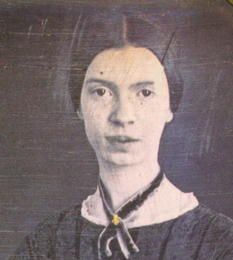
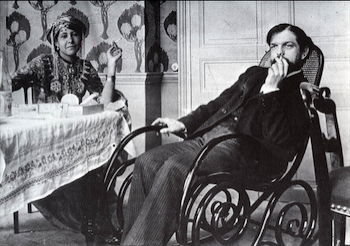
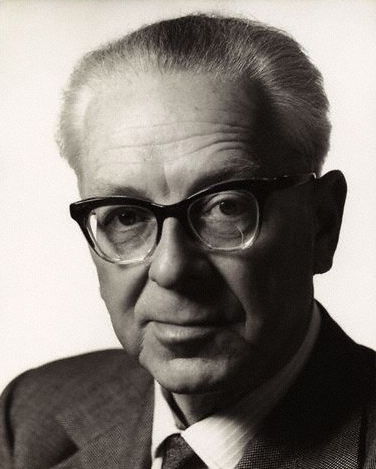
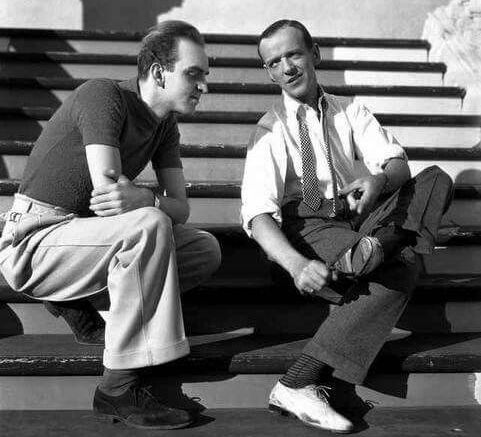
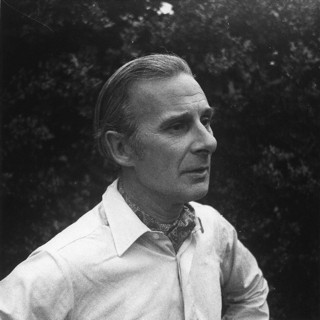
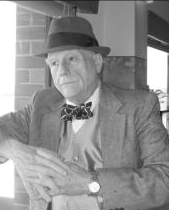

 Roger Brown: portrait by Francois Robert
Roger Brown: portrait by Francois Robert